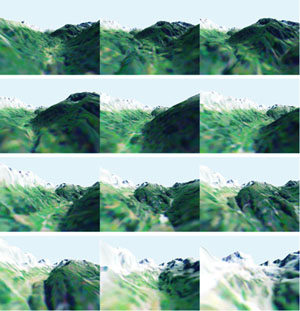1.1.2. Animation Techniques
According to (1997), there are three main techniques to create animations:
- Frame by Frame Animation: This is the simplest form of animation. Each frame is created by the animator. The frames are finally combined into an animation.
 Different Frames (data source: © Atlas of Switzerland 2004) Different Frames (data source: © Atlas of Switzerland 2004) |
Resulting Animation (data source: © Atlas of Switzerland 2004) |
- Keyframe Animation: This animation
technique is based on the interpolation of so called keyframes. The animator
does not create anymore all frames but only the start and end frames
(keyframes) of a sequence. The inbetween frames (inbetweens) are
automatically created by the computer by interpolating the
keyframes.
The result of keyframe animations are - like in a frame by frame animation - many frames that are combined into an animation. The difference is that only the start and the end frame has to be produced by the animator and all the other frames are computed by the computer.
| Keyframe Animation |
- Procedural or algorithmic Animation :
The whole animation is created by programs. The animator defines the
objects, their mutations and the temporal sequence of the animation in a
program. With this animation technique, it is possible to output the
animation in real time, thus simultaneous to the computation and
generation.
Like in the keyframe animation, the result of this technique are many frames that are combined into an animation, but the animator does not have to create the individual frames.
| Procedural Animation (doesn't work in Firefox) |
